
Overland Tech and Travel
Advice from the world's
most experienced overlanders
tests, reviews, opinion, and more
The trusty Motorola 9500
 Shortly after we published the story of our BGAN review in Mexico (here), which became a real-life test of the technology, I got an email from our friend John Knights, a senior Land Rover Experience instructor in the UK who’s also been on and led many major expeditions in Africa. John bought one of the very first Motorola 9500 satellite telephones in 2001, and has been using it since.
Shortly after we published the story of our BGAN review in Mexico (here), which became a real-life test of the technology, I got an email from our friend John Knights, a senior Land Rover Experience instructor in the UK who’s also been on and led many major expeditions in Africa. John bought one of the very first Motorola 9500 satellite telephones in 2001, and has been using it since.
The 9500 was a bellweather in the development of satellite telephones. When I made my first sat phone call in 1999, from a camp in Zambia, the device I used required a bulky tri-fold antenna which had to be precisely aligned, and which came with dire warnings not to stand within three meters of the front of it. Just two years later, when the financially troubled Iridium network finally got up and running for the final time, you could make the same call with a one-piece handheld 9500 and stand anywhere you wanted (as long as it was outside).
Since then, John has used his 9500 on more than one occasion to manage emergencies in the bush—some of them mere inconveniences, some of them more serious. Here are a few of his recollections.
Zimbabwe 2001 (chasing a total solar eclipse in the north of the country): The Defender 130 we had hired blew out two tire sidewalls. Although it was equipped with two spares, once both were used we would have been stranded had we suffered another blowout—highly likely on remote African dirt roads. A quick call to the hire company office had two spare tyres and inner tubes on a light aircraft to a nearby safari lodge, who dropped them off in a powerboat to where we were camped on the shores of Lake Kariba.
Death Valley 2002 (touring the scenic Wild West in a rented SUV): We had journeyed off the beaten track to see the famous moving rocks. Returning down the rough dirt track, we were passed at speed by another SUV. They shot off into the distance, and I commented, “He must have much better suspension to travel at that speed on this road.” A few corners later we found the SUV, wrecked—he had lost control and hit an embankment, launching the car airborne, going end over end twice before landing back onto its wheels. Thankfully the occupants where unharmed, but had no supplies or recovery gear with them and were surprised their mobiles did not work. I produced my trusty Motorola, rang the ranger station number off the park map, gave them our exact position from my GPS, and waited until the rangers arrived. In the meantime we found out the family concerned were also in a rented SUV and were due to fly home that evening. I’d love to know what he told the hire company!
Australia’s Blue Mountains 2003: Touring in a hired car we came across a 4x4 on its side. The driver had gotten into a skid on the loose gravel road, and aimed for the embankment rather than the drop off. Again everyone safe but no mobile coverage, but a swift call from the Iridium had a rescue on the way.

Namibia 2003: We set a new record on this trip for number of days without a puncture (seven I think), but that meant we were in the middle of nowhere when the first one happened. The puncture itself was not a problem, but when the locking wheel nut key split while reinstalling the wheel, it did create a problem when we had a second puncture and could not remove the locking nut. Again an Iridium phone call to the hire office had a man with a hammer and chisel on the way, although we did have to spend an unexpected extra night out on route. Our journey was not actually saved by the man with the chisel, but buy the sister vehicle to ours from the hire fleet. The guests driving it rolled it over a couple of miles from where we were. Armed with their wheel nut key we were able to remove our flat tyre, and we then took normal wheel nuts and spare tyres from the wrecked 110 to allow us to continue.*
Whilst I would love to have an all-singing-all-dancing satellite communication set up that gave me calls, high-speed internet, and a wifi hotspot, at the end of the day the ability to raise any help is a blessing and I’m sure my trusty 9500 will see a few more adventures yet.
Ocens (here) carries the full line of Motorola satellite telephones, including the current 9555.
* An easy trick (no doubt discovered by wheel thieves) is to find a 12-point 1/2-inch drive socket that's just too small to fit over the locking lug nut, hammer it over the nut, then use a breaker bar to remove it. I've used the technique a half-dozen times and have yet to fail. JH

Home-away-from-home tour (JATAC update)

Everyone—everyone—who sits for the first time in the dinette of our Four Wheel Camper and looks around, says exactly the same thing: “I can’t believe I’m in the bed of a Toyota pickup.”
It’s understandable. We had the same reaction when we sat in our first FWC in 1994, and that one fit our compact 1992 Toyota pickup. The new, wider Fleet model on the new, wider Tacoma displays even more of a fifth-dimension sort of spatial trickery. There’s a bed the size of a couple of barroom pool tables over the truck's cab, comfortable eating (or laptop working) room for two at that front-mounted dinette—underneath which is the grate for the hot shower. The galley (a term that seems more nautically jaunty than kitchen) incorporates a two-burner stove, a sink with pressure water fed from a 20-gallon tank, and a proper, compressor-driven fridge with freezer compartment. There’s storage everywhere, and a Porta Potti tucked under a back cabinet, across from two deep-cycle batteries. Overhead, LED lighting renders the interior as bright as you want when natural light isn’t flooding in through the four huge screened windows in the canopy.
Our first FWC seemed luxurious at the time. The new one, as I mentioned to Roseann, seems like the old one after it won a spot on Xtreme Kamper Makeover. Here's what it looks like inside.
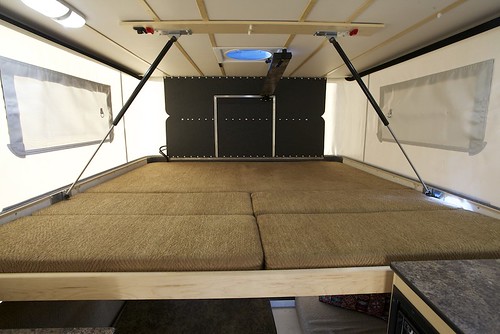 Looking forward over the truck's cab. The bed in its extended position is . . . big (a bit over six feet wide and seven long), and the cushions are thicker than on our first FWC. Since both of us are under six feet (I'm 5'9"), we can sleep sideways even on this mid-size model, which allows us to leave two of the near cushions at home to save space (they won't fit on top of the main cushion when the camper's roof is closed). We worried that the gas lift-assist struts would be in the way, but that hasn't been the case—there's plenty of room behind them for both of us.
Looking forward over the truck's cab. The bed in its extended position is . . . big (a bit over six feet wide and seven long), and the cushions are thicker than on our first FWC. Since both of us are under six feet (I'm 5'9"), we can sleep sideways even on this mid-size model, which allows us to leave two of the near cushions at home to save space (they won't fit on top of the main cushion when the camper's roof is closed). We worried that the gas lift-assist struts would be in the way, but that hasn't been the case—there's plenty of room behind them for both of us.
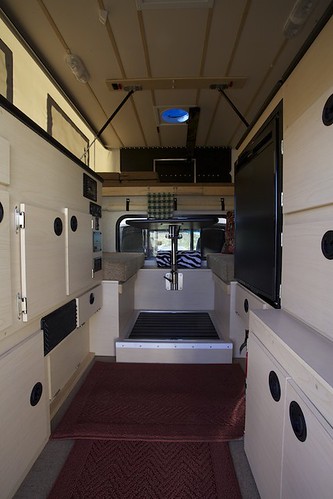 Looking in from the door. Lots of storage in the cabinets on either side. A Porta Potti fits in the near-right-side bottom cabinet. Cabinet materials and hardware are much improved over early models. The black door is the Dometic two-way fridge (12VDC and 120VAC). The grate for the shower is visible under the dinette table; the curtain tucks underneath it and clips to hooks on the ceiling. Controls and plug-in for the shower hose and wand are behind a hatch around the corner of the left cabinet (visible in top photo). The wand has a button that stops flow to conserve water. Duplicate shower controls are outside for remote/fair-weather bathing.
Looking in from the door. Lots of storage in the cabinets on either side. A Porta Potti fits in the near-right-side bottom cabinet. Cabinet materials and hardware are much improved over early models. The black door is the Dometic two-way fridge (12VDC and 120VAC). The grate for the shower is visible under the dinette table; the curtain tucks underneath it and clips to hooks on the ceiling. Controls and plug-in for the shower hose and wand are behind a hatch around the corner of the left cabinet (visible in top photo). The wand has a button that stops flow to conserve water. Duplicate shower controls are outside for remote/fair-weather bathing.
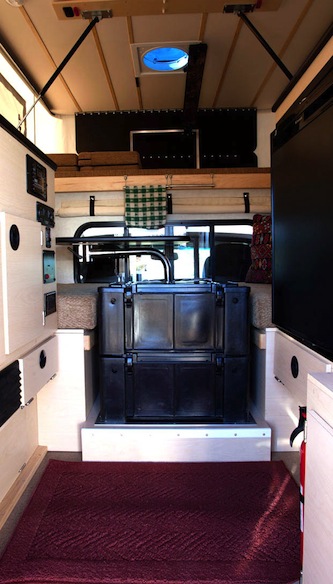 We discovered that two low-profile Bundu boxes from BunduGear.com fit perfectly onto the slightly recessed shower grate; we added a strap across the top and we have excellent storage for tools, boots, firewood, etc.
We discovered that two low-profile Bundu boxes from BunduGear.com fit perfectly onto the slightly recessed shower grate; we added a strap across the top and we have excellent storage for tools, boots, firewood, etc.
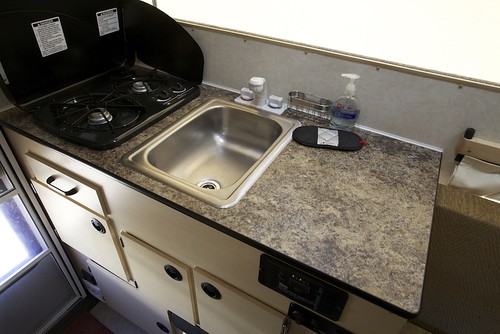 Hot and cold pressure water; water heater adds six gallons to the total water capacity (main tank is 20 gallons). Standard two-burner stove; a recessed stove with smoked-glass cover is optional, with a matching sink (also covered with smoked glass). Good working room on the right and also on the cabinet top above the fridge opposite. Silverware drawer could be bigger.
Hot and cold pressure water; water heater adds six gallons to the total water capacity (main tank is 20 gallons). Standard two-burner stove; a recessed stove with smoked-glass cover is optional, with a matching sink (also covered with smoked glass). Good working room on the right and also on the cabinet top above the fridge opposite. Silverware drawer could be bigger.
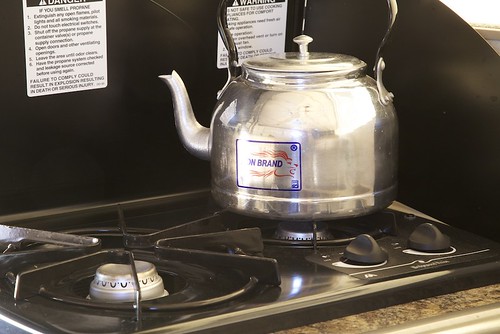 Stove has room for one big pot and a smaller one (or kettle). This stove has no pietzo ignition, and the rear burner is tricky to light with a match, especially if the front burner is already on. A gas match helps a lot. However, it's clear from the warning labels that if you actually use this stove YOU WILL DIE.
Stove has room for one big pot and a smaller one (or kettle). This stove has no pietzo ignition, and the rear burner is tricky to light with a match, especially if the front burner is already on. A gas match helps a lot. However, it's clear from the warning labels that if you actually use this stove YOU WILL DIE.
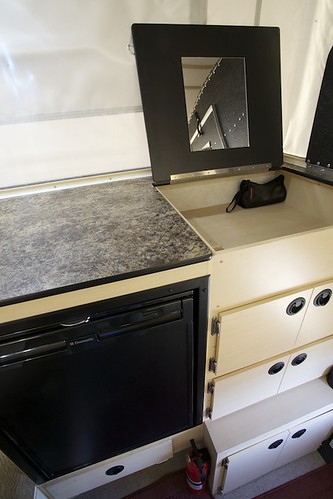 Vanity with mirror and storage has proven perfect for toiletries, clean towels, and small clothes. The Dometic fridge has a venting latch that holds the door slightly open when not in use.
Vanity with mirror and storage has proven perfect for toiletries, clean towels, and small clothes. The Dometic fridge has a venting latch that holds the door slightly open when not in use.
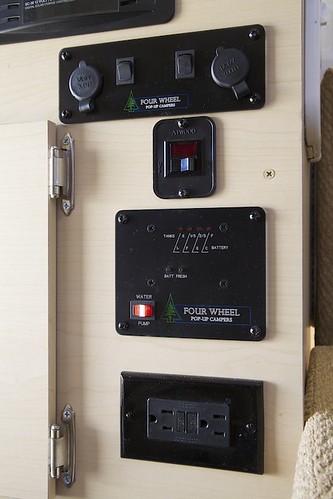 Control panel. Cut off at top is the Global Solar charge controller and monitor. Underneath are two switched 12V outlets. Beneath them is the switch for the water heater; beneath that is a dual monitor for battery level and water level, with a switch to power the water pump for the sink and shower. 120V outlet is active when hooked up to shore power.
Control panel. Cut off at top is the Global Solar charge controller and monitor. Underneath are two switched 12V outlets. Beneath them is the switch for the water heater; beneath that is a dual monitor for battery level and water level, with a switch to power the water pump for the sink and shower. 120V outlet is active when hooked up to shore power.
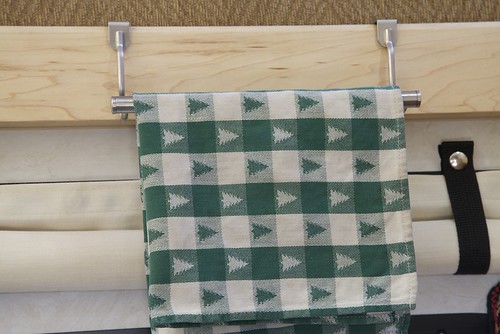 Inexpensive custom touches: Roseann found these towel bars at Target.
Inexpensive custom touches: Roseann found these towel bars at Target.
 More customizing, courtesy Target: An inexpensive yoga mat was cut up to fit every cabinet bottom to reduce sliding and scuffing; a compact dish holder/drainer; folding fabric bins; spring-loaded curtain rod keeps items secure on shelf.
More customizing, courtesy Target: An inexpensive yoga mat was cut up to fit every cabinet bottom to reduce sliding and scuffing; a compact dish holder/drainer; folding fabric bins; spring-loaded curtain rod keeps items secure on shelf.
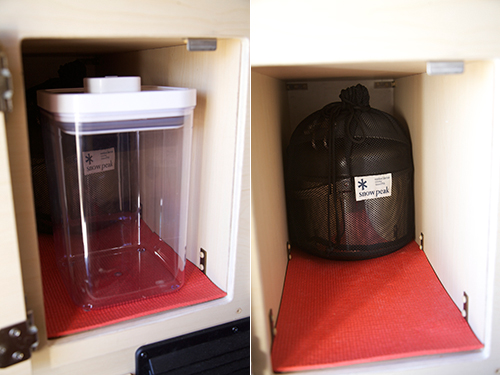 To the right of the under-sink storage is a deep, tall cabinet in which perfectly fits a 4L airtight OXO canister that we use for "wet" (i.e.: stinky) garbage like onion cuttings or coffee grounds; and behind it, a Snow Peak Multi-Purpose Cook-Set 3 (nesting 2 stainless pots, strainer, lids, and cast iron fry pan).
To the right of the under-sink storage is a deep, tall cabinet in which perfectly fits a 4L airtight OXO canister that we use for "wet" (i.e.: stinky) garbage like onion cuttings or coffee grounds; and behind it, a Snow Peak Multi-Purpose Cook-Set 3 (nesting 2 stainless pots, strainer, lids, and cast iron fry pan).
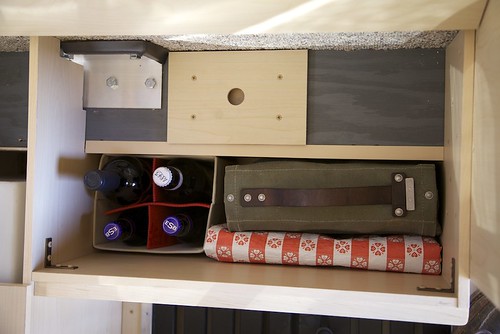 And . . . the bar is open. Under the right dinette seat was this spot perfect for safe storage of vital liquids. Swiss ammunition case holds larger bottles of more serious stuff. Hatch with finger hole is access to turnbuckles that secure the camper to the truck's bed.
And . . . the bar is open. Under the right dinette seat was this spot perfect for safe storage of vital liquids. Swiss ammunition case holds larger bottles of more serious stuff. Hatch with finger hole is access to turnbuckles that secure the camper to the truck's bed.
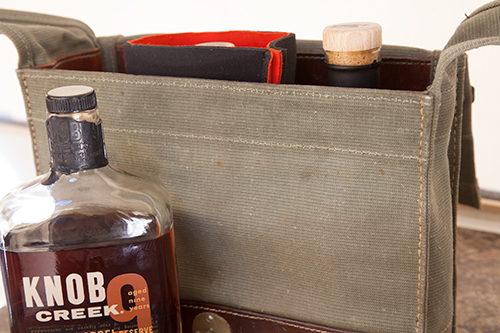 Detail of the Swiss ammo bag converted to travelling bar. A very good friend gave us this as a camper-warming present. Shorter bourbon and whisky bottles fit perfectly.
Detail of the Swiss ammo bag converted to travelling bar. A very good friend gave us this as a camper-warming present. Shorter bourbon and whisky bottles fit perfectly.
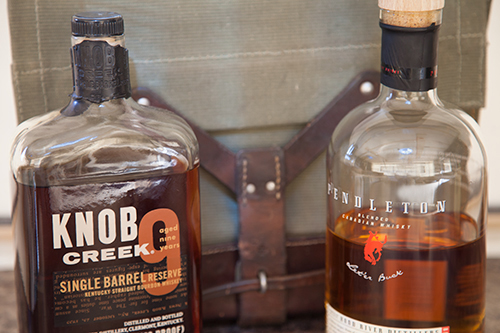
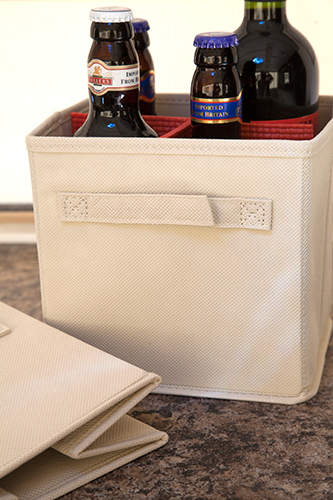 Detail of the Closet Maid mini fabric cubes (7.5 x 5 x 5) from Target, which fold flat when not needed. Roseann cut leftover pieces of the yoga-mat padding to make bottle protectors (could there possibly be a better use for a yoga mat?). These cubes fit perfectly in the narrow spaces under the seats and three-across in the pantry storage (under the vanity).
Detail of the Closet Maid mini fabric cubes (7.5 x 5 x 5) from Target, which fold flat when not needed. Roseann cut leftover pieces of the yoga-mat padding to make bottle protectors (could there possibly be a better use for a yoga mat?). These cubes fit perfectly in the narrow spaces under the seats and three-across in the pantry storage (under the vanity).
Sources:
Bundu boxes - BunduGear.com
Global Solar panels and charge controller - GlobalSolar.com
Snow Peak cookset - SnowPeak.com
OXO canister, dish drainer, towel bars - Target.com
ClosetMaid Mini Fabric Drawers - Target.com
Swiss ammunition bags - try your local military surplus store, eBay, or here
Good friend who gives you three bottles of best whisky and bourbon as a camper-warming - find your own
Easy trip assistance app
 by Roseann Hanson
by Roseann Hanson
How many times have you been reading a magazine or book, and come across some place you want to jot down to remember to visit, such as a landmark, a restaurant, a museum, or a trail?
In the past I either scribbled these onto a nearby post-it note or in a file on my computer. Inevitably these got lost in the shuffle of life, or are too difficult to locate when I knew I was going to be in a certain place, or I just plain forgot to bring my file with me.
Recently friends mentioned how interesting Scotty's Castle was on their overland trip through Death Valley. I started to jot it down in a notebook in the truck, but then thought, I wonder if there is an app for that?
Ever the fan (and growing) of organizing my life by iPhone, I searched the AppStore for "record places" or "remember places." One of the first to come up was the very promising My Places by VoyagerApps.com. Using your GoogleMaps account, it promises to let you see and organize your saved "places" in real time. I downloaded the free version to test it out, but unfortunately it was so annoying, I deleted it. The free version won't let you do anything without constant interruptions from pop-up notifications asking if you want to download and try other apps (presumably by VoyagerApps.com)—a different ad popped up every 30 seconds, literally, and you have to stop and click "No, thanks" every time. Then it would not let me save anything or see my Google places unless I bought the app, so I could hardly see if it worked or not. I don't mind buying apps, but this was a real stinker.
Then I tried a cool-sounding app called PintheWorld, which allows you to pin and save places of interest, give them categories (different colored pins, too), and see them when passing through a location. Sounded perfect! But unfortunately the developer uses the new iOS 6 in-house (and yes, totally lame) Apple Maps app and it is so inaccurate and picky, I could not find businesses I knew were there. The trick turned out to be that you have to type the exact, and I do mean exact, address down to the country and zip code. And then you have to manually name it and add details. Too much work. I just knew, with the power of the Internet and Apple, there had to be a solution.
Turns out it was right there all along: Google just released their brilliant Google Maps app for iPhone—pair it with your Google Maps account, and you're good to go.
(For those of you who haven't followed the little cyber drama between Google and Apple, Google was the original driver behind the superb Maps app on the iPhone but last year Apple and Google's relationship melted down, and Apple replaced Google as the data source with TomTom. My own side-by-side comparision between Google Maps and the Apple iOS 6 Maps bore out all the crazy criticism of the incredibly bad app. The famous tech geek David Pogue even called it "the most embarrassing, least usable piece of software Apple has ever unleashed." I could call up Google Maps, looking for the new Wanderlust Brewery in Flagstaff and up it pops . . . on Apple's Maps it fails to find anything, or sends me to Connecticut.)
But back to how to use the Google Maps and your Google account to save cool places to visit (after downloading Google Maps app you need to pair it with your online Maps.Google.com account).
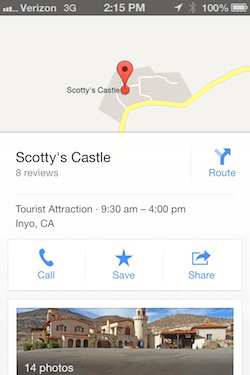 I wanted to save Scotty's Castle as a place of interest, so I just hit the search bar, typed in Scotty's Castle, and up it pops (see screen shot, right). Swipe up on the name Scotty's Castle in the bar at the bottom, and it gives you a menu of buttons—Call, Save, Share. Hit Save, and it puts it into your Google Places.
I wanted to save Scotty's Castle as a place of interest, so I just hit the search bar, typed in Scotty's Castle, and up it pops (see screen shot, right). Swipe up on the name Scotty's Castle in the bar at the bottom, and it gives you a menu of buttons—Call, Save, Share. Hit Save, and it puts it into your Google Places.
On this screen you can also browse things like photos, hours, reviews, distance from current location, and other useful information.
Then, next time I'm in Death Valley area, and I want to see if it's nearby, I fire up Google Maps app and any saved Places show up as yellow stars (see below).
I am trying to find out if the star colors can be changed, because the yellow is hard to see against the yellow roads. And they only show up at a certain zoom magnification.
The next screen-shot set below shows all the restaurants and cafes saved for Flagstaff, near Overland Expo. Click on a star and a pin pops up; click on the pin and you get the easy-to-read information popup at the bottom (swipe it up to see the details).
Ideally Google will eventually let us categorize and organize our Places, and edit them from either the app or through the Maps.Google.com. It would be nice to filter for things like restaurant, art gallery, museum, trail, or other category, to help minimize clutter if you have marked a lot of places in one area.
But otherwise it looks like it's going to be a very useful tool for travel anywhere.
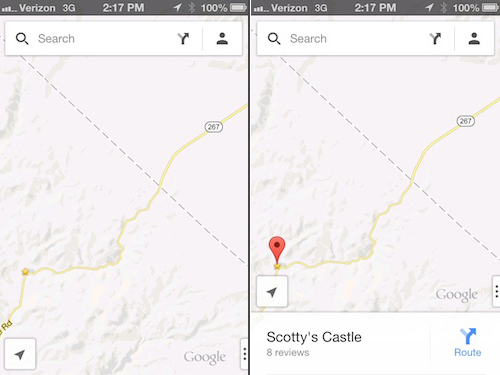
 Google Maps app is great for storing places you want to visit, like these restaurants and cafes in Flagstaff, near Overland Expo.
Google Maps app is great for storing places you want to visit, like these restaurants and cafes in Flagstaff, near Overland Expo.
The one-case tool kit, part 2

(Read part 1 HERE.)
By their nature, field repairs lend themselves to chaos: Something unexpected has happened in an unexpected place—often, given the capriciousness of the overlanding gods, at an inconvenient time in inconvenient conditions. Thus, organization is nearly as vital to a traveling tool kit as comprehensiveness and quality.
Since I’m disorganized and absent-minded to begin with this takes on triple importance. If I don’t have a specific spot for every single item in my tool kit so that the hole is obvious as I’m packing up, I won’t just leave a socket in the dirt—I’m also likely to forget a wrench on a chassis rail, an extension balanced on top of a tire, and a screwdriver or two on the inside fender. I need my tools laid out like a surgeon doing a kidney transplant just to change a windshield wiper.
I started thinking seriously about tool organization when we had three four-wheel-drive vehicles in use at the same time—two of our own and a Jeep on loan from Chrysler. Despite my best efforts, tools wound up scattered among all three trucks, so when I needed the wrench set in the FJ40, it was in the FJ60. Socket to tighten the perpetually loosening battery hold-down on the Jeep? Sorry, the sockets are in the 40. Eventually I was able to equip each vehicle with basic stuff, but I decided I wanted a comprehensive kit that would fit in one case, never be separated, and could be tossed (or, um, as it turned out, heaved) into whichever vehicle was leaving on a major trip.
Rather arbitrarily I decided on a Pelican 1550 case. It’s 18 by 14 by 7.6-inch interior dimensions seemed to be about right to accommodate the selection of tools I hoped to fit inside—which, as detailed in the previous article, I wanted to make comprehensive enough to handle virtually any field repair up to and including transmission removal, differential or axle replacement, and major suspension work.
The first thing in was a 3/8ths-inch-drive socket and ratchet set—the most commonly needed tool set for most minor repairs. I looked everywhere for one that had the quality I wanted, the compactness I needed, and the selection of sockets I felt was essential, without blowing the budget. I could have gained the compactness by simply dumping a bunch of sockets in a pouch or fitting them to socket rails and storing the ratchets and extensions separately, but I’ve come to appreciate the organization intrinsic to socket sets that come in lidded, compartmented cases. Not only is everything in the set always together, neatly laid out, and instantly accessible; any missing piece is easily noticed when packing up.
 Quality and supreme organization: Britool 748267Everything—quality, selection, and compactness—came together in a set from Britool, the venerable British manufacturer that supplied tools to Spitfire mechanics in 1940. The Britool 748267 set is a miraculously packaged assortment that includes SAE sockets from 1/4 to 1-inch, metric sockets from 6 to 24mm (not skipping any, like many sets do maddeningly), deep sockets from 5/16 to 3/4-inch and 6 to 19mm, a nice 72-tooth ratchet handle, a sliding T-handle (good backup if the ratchet fails), three different extensions, each with knurled finger grip and a hex fitting on top so one can apply a wrench if needed, a universal joint, and two adapters—plus several spline-drive sockets and a complete selection of slotted, Phillips, Torx, and hex bits with bit adapter. The lot is laid out cunningly in a plastic case just 10 by 15 by 3 inches. Amazing, and the quality is first-rate: All the tools have an even satin finish, the sockets employ the “Flank Drive” system, the short extension has a wobble end if you need to access a slightly off-center nut, and the ratchet head is user-serviceable. (Incidentally, the sockets are all 6-point rather than 12. At home I prefer the ease of use of 12-point sockets—which you don’t have to turn as far to fit over a nut or bolt—but for ultimate strength in a field kit the 6-point design makes sense.)
Quality and supreme organization: Britool 748267Everything—quality, selection, and compactness—came together in a set from Britool, the venerable British manufacturer that supplied tools to Spitfire mechanics in 1940. The Britool 748267 set is a miraculously packaged assortment that includes SAE sockets from 1/4 to 1-inch, metric sockets from 6 to 24mm (not skipping any, like many sets do maddeningly), deep sockets from 5/16 to 3/4-inch and 6 to 19mm, a nice 72-tooth ratchet handle, a sliding T-handle (good backup if the ratchet fails), three different extensions, each with knurled finger grip and a hex fitting on top so one can apply a wrench if needed, a universal joint, and two adapters—plus several spline-drive sockets and a complete selection of slotted, Phillips, Torx, and hex bits with bit adapter. The lot is laid out cunningly in a plastic case just 10 by 15 by 3 inches. Amazing, and the quality is first-rate: All the tools have an even satin finish, the sockets employ the “Flank Drive” system, the short extension has a wobble end if you need to access a slightly off-center nut, and the ratchet head is user-serviceable. (Incidentally, the sockets are all 6-point rather than 12. At home I prefer the ease of use of 12-point sockets—which you don’t have to turn as far to fit over a nut or bolt—but for ultimate strength in a field kit the 6-point design makes sense.)
Before you stop reading and Google “Britool 748267,” I have to tell you that, apparently about 15 minutes after I bought my set, the company not only stopped production, but re-designed their entire tool line into something called Britool Expert, which, if my evaluation of a sample 1/2-inch socket set is any indication, is a step down in quality. If I’d known it at the time I would have taken out a loan, bought 50 of the 748267 sets, and would now be offering them at some usurious markup.
In the last two years, I’ve tried and failed to find a 3/8ths-inch socket set that comes close to the Britool 748267 paradigm. I discovered plenty of compact pot-metal sets from Far-East importers, and high-quality sets that took up too much room—never the right combination. A set from Sears came close, but the metric sockets ended infuriatingly at the relatively useless 18mm without including the frequently-required 19mm.
 Craftsman "Max Axess" - nice, but what's with the microscopic sockets?
Craftsman "Max Axess" - nice, but what's with the microscopic sockets?
Right now I’m evaluating another Craftsman set that employs the “Max Axess” design, meaning the sockets, ratchet head, and even extensions are all hollow-centered, thus obviating the need for deep sockets—you can slide a ratchet and socket over a nut even if the stud to which it’s attached sticks out ten inches. It combines a large and small ratchet, two short extensions, and metric and SAE sockets from 3.5 to (thank you!) 19mm, and 5/32 to 7/8-inch. (Not sure about the need for the microscopic 3.5mm and 5/32 sockets, but . . .) Sears says the 72-tooth ratchet is 45 percent stronger than their most popular ratchet, and the splined socket/ratchet interface appears to be at least as strong as the standard square drive, although I worry a bit about the strength of the hollow extensions—and the complete lack of longer extensions. The set is very well-organized, and very space-efficient in its case, although it still doesn’t match the tool density of the Britool 748267. (In a moment of helpless tool geekiness I figured out the tool/volume ratios for several cases. The Craftsman case encloses 7.6 cubic inches per item inside; the Britool case only 7.1 cubic inches—and I didn’t count the bit assortment.) The biggest problem I’m having with the Craftsman kit at the moment is that it sometimes feels backwards: The smaller end of the extension fits into the ratchet, and the larger end goes over the back of the socket. If you’re interested, it was here as of this writing, for a bargain $60.*
Next up was the critical 1/2-inch-drive socket set. As I wrote in part one, I always figure that if I break out the 1/2-inch set on the road, it’s because something major needs repair—something quite likely to have stopped the vehicle or at least seriously affected it. So, more than any other component of the entire tool kit, I wanted to insure I had the highest quality 1/2-inch sockets and ratchet . . . yet I still wanted it to be compact, and preferably in its own case that would fit into the 1550. I had just put together a comprehensive eBay-sourced loose set of 1/2-inch-drive Snap-on sockets, but they’d pretty much been integrated into my rolling cabinet at home; plus, they were all 12-point sockets, and I wanted six-point for field use.
 Britool "Expert." Not bad, but . . .
Britool "Expert." Not bad, but . . .
I tried a Britool Expert set, in the new blue-case-and-handle color scheme. It was compact and comprehensive—but I just wasn’t comfortable with the looks or feel of it. The chrome was thick, but orange-peeled in spots, and several features of the earlier Britool products had been eliminated. The ratchet mechanism didn’t feel perfectly consistent. Strangely, the word “Britool” appears nowhere—is the company afraid to have those old Spitfire mechanics associate the name with this stuff? It wasn’t really bad, just . . . Anyway, I kept looking.
Sears—nothing. Harbor Freight—just kidding. Then I discovered France.
Say what? Actually I’m referring to Facom ("Fahcomb"), a 90-year-old French tool maker that’s been called “the Snap-on of Europe.” Even though now owned by Stanley, and now basing production of some components in Taiwan, Facom seems to have retained its high standards; in fact I’ve seen a few web comments claiming the finish on the Taiwan pieces is a step up from the later France-sourced products. The Facom 1/2-inch-drive S.200DP metric set nearly matched the Britool Expert case in volume efficiency, had noticeably better finish, and included sockets from 10mm all the way up to a crankshaft-pulley-sized 32mm (the S.6BP is very similar, lacking only the shorter extension). I’m not fond of the palm-control directional switch on the ratchet—I prefer a lever—but it has a smooth and even 72-tooth action and is easily serviceable. Combined with the exquisite Snap-on 18-inch flex ratchet I detailed last time, I now feel I’ve got a nearly perfect 1/2-inch socket array.
Did I go off the deep end just to find good socket sets that happened to come in compact, compartmented cases? I can hear some of you (including Roseann) saying, “Uh, yeah . . .” and perhaps you’re right. Okay, you’re almost certainly right. For me that compartmentalization adds a sense of order that I find incredibly valuable when I’m lying on my back in the dirt under a dangling part of a vehicle that shouldn’t be dangling. The downsides are price—I paid significantly more for these neatly-packaged tools than I would have buying, say, open-stock Craftsman tools and finding my own boxes—and warranty coverage: I’m pretty sure there are more Sears stores in the U.S. than Facom dealers (not to mention the no-longer-made Britool kit)—but then again I have very little fear of these breaking. The cases add some weight to the whole tool kit—and despite my obsession with volumetric efficiency, they take up more space than a socket rail and a small tool roll. However, I’ve been using the evolving core of this kit in the field for two years now, and I’ve yet to regret the trouble it took to put together. Most telling: I have yet to leave a single socket in the dirt.
Next: Screwdrivers you can hammer on, a cheap hacksaw that beats out an expensive one, and a fitting that converts your ratchet into a torque wrench. Read part 3 HERE..
The main U.S. Facom distributor is Ultimate Garage.
*Addendum: The jury is in on the Max Axess kit, and it's thumbs down. The biggest problem is the bulk of the extensions, which as mentioned fit over the socket. Twice in the brief time I was evaluating the set that bulk posed problems getting "axess" to nuts close to other parts. Also, the lack of a longer extension has proven to be a very real drawback. Sorry Sears.
 Note the extra diameter of the Max Axess extension on the bottom. Each extension has a 14mm socket attached. (Note here too the nice knurling and wrench-compatible hex end of the Britool extension.)
Note the extra diameter of the Max Axess extension on the bottom. Each extension has a 14mm socket attached. (Note here too the nice knurling and wrench-compatible hex end of the Britool extension.)
Chris Scott's Adventure Motorcycling Handbook, 6th edition

I can think of no higher compliment to give Chris Scott’s Adventure Motorcycling Handbook than to say it is without doubt motorcycling’s equivalent to the Vehicle Dependent Expedition Guide, Tom Sheppard’s seminal and authoritative bible for four-wheeled expedition travel. The Adventure Motorcycling Handbook has just been released in a well-deserved sixth edition, and has once again been thoroughly revised and updated to include the most up-to-date information possible regarding planning, motorcycle selection, ancillary equipment, route possibilities, shipping, political situations—essentially about 90 percent of what you’d need to embark from scratch on a major motorcycling excursion, short of actual riding instruction (which you could get at the 2013 Overland Expo after buying the book directly from Chris).
The Adventure Motorcycling Handbook is a lively read, whether you’ve committed to a cover-to-cover marathon prior to buying a Ténéré and departing for Tamanrasset, or are just flipping and browsing for amusement. In addition to in-depth articles there are maps, many short, handy charts, and a good hundred text boxes: a complete Cyrillic alphabet, a primer on GPS, a section on black markets and bargaining, a brilliant two-page motorcycle troubleshooting guide, and, of course, a for-and-against chart comparing hard and soft luggage. Lois Pryce contributed a delightful and informative section on women riders titled “Adventure motorcycling—the bird’s-eye view,” which you’ll get if you know British slang. Grant Johnson penned the chapter on shipping—it would be difficult to find someone more knowledgeable on the subject. And Gaurav Jani, the solo traveler and filmmaker, discusses touring India and the Himalayas on a Royal Enfield—surely the only really stylish way to do so. There are a good two dozen other contributors as well.
The first half of AMH deals with preparation, equipment, and life on the road; the second half comprises route guides to Asia, Africa, and Latin America respectively. The route guides rightly concentrate on practicalities of money, border crossing formalities, customs, and so forth, and only briefly touch on main routes and sights. (I suggest augmenting the AMH with a Rough Guide once you’ve decided where you’re riding.) Finally, the last chapter, “Tales from the Saddle,” is worth the price of the book on its own.
No such work is perfect, but I had to look closely to find flaws in the Adventure Motorcycling Handbook. Many sections were simply beyond my areas of expertise so I wouldn’t even attempt to critique them, but in other areas I noticed a few glitches, and one ancillary section contains misinformation I’d classify as potentially dangerous.
Some of the details on country information appear to be outdated or cursory. I imagine this is somewhat inevitable even in a regularly revised book; it’s just not possible to maintain perfect accuracy without a Fodor’s-sized staff. For example, the section on Kenya describes the equatorial town of Nanyuki as lacking anything but basic groceries; in fact there’s been a giant full-service Nakumatt there for at least a couple of years (along with a Dorman’s, perhaps the finest coffee chain on the planet, and a chemist stocking what is definitely the highest-priced sunscreen on the planet). The Namanga border-crossing section lists the price for a Tanzania visa at $50; but for some years it’s been $100 for U.S. (and, peculiarly, Irish) citizens, and U.S. bills must be dated later than 2006—two missing pieces of information that could cause significant hassle.
There’s a single page in AMH titled “Survival,” the information in which is so scant it would have been better left out altogether. Another section on (or rather, against) weapons clearly betrays an editorial viewpoint rather than objective information. Of course it’s Chris’s book and editorial stance, but knowing of several instances in which travelers saved their money and vehicle if not their skins by analyzing the threat and meeting it with aggressive resistance, I think readers would have been better served by a fair look at both sides of the issue.
Oh, and . . . the dangerous bit? All I’ll say here is, Chris, for God’s sake talk to me before you print the venomous snakes section in the seventh edition. The rest of you, ignore the entry (except for the perfectly true advisory that bites from such snakes are extremely rare) and consult a current source of information if you plan travel where venomous reptiles might be present - this particularly refers to the suggestion to wrap the bitten limb, which is contraindicated for many species. Rather surprisingly, Wikipedia has an excellent page on the subject in general, and good first-aid advice, here.
Aside from the snake-bite treatment suggestions, the Adventure Motorcycling Handbook remains the standard by which all its imitators will be judged—that is, if anyone ever works up the nerve to imitate it. Most highly recommended.
$23.95 Available direct from—well, through—the book’s website here.
The TrekPak divider system
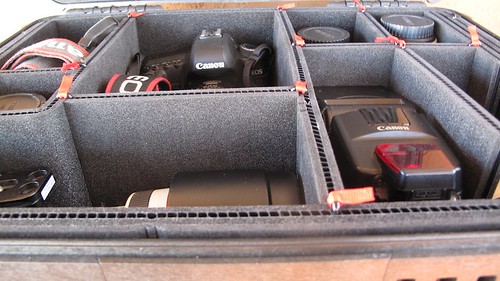
Few experienced travelers, photographers, or scientists would dispute that the ubiquitous Pelican case is the ultimate traveling container when the contents absolutely, positively have to stay protected from impacts, crushing, and dust and moisture incursion. I certainly wouldn’t argue (see here). I know someone who had to move several large Pelican cases full of equipment across an arctic inlet—by sea kayak. He simply rafted the cases behind the boat and towed them across. No problem. If you can deal with the relatively high weight of the empty Pelican, and the just-so-so volumetric efficiency, nothing will give you as much peace of mind when the equipment inside is worth quite literally 40 or 50 times what the case cost. It’s the cheapest kind of insurance.
But you can’t just toss your photography or video equipment inside a big plastic box, however sturdy. You need interior padding and organization. And that presents a bit of a dilemma.
The Pelican can be equipped with either of two options from the factory. The “Pick N Pluck” interior comprises an open-cell foam filler that is partially pre-cut into small square sections. You tear free the sections you want to create pockets to fit camera bodies, lenses, or other items. The result is snug and secure; however, once done you can’t re-organize to accommodate new or replacement equipment, and you must leave at least two cube-widths of the soft foam between items or the structural integrity collapses. That reduces available room significantly. Also, with constant use the open-cell foam degrades rather quickly. I’ve found the Pick N Pluck interior best when a case is devoted to one very expensive or fragile item, such as a monster 600mm F4 telephoto, where the tight fit and thick cushioning provide excellent impact resistance.
The other Pelican option is a set of padded, nylon-covered dividers, which rearrange and connect via hook-and-loop strips. This interior can adapt to new contents, but it’s quite limited in configuration and thus tends to waste space, and the hook-and-loop material is fiendishly efficient at collecting and holding on tightly to all sorts of debris, which eventually reduces its grip on itself.
Aftermarket options have been around for a long time, but every one I’ve used—such as the otherwise superb Lowepro Omni Pro in the link above—wastes a lot of volume due to redundant lids and straps, and dividers that are actually over-padded. How often I’ve wished for a thinly but densely padded divider system that wouldn’t rely on Velcro, had more structural integrity than open-cell foam, and could be re-organized easily to “suit the mission.”
Thanks to, of all things, Kickstarter, I may have gotten my wish. A new company called TrekPak has (rather spectacularly) defied recent odds on the crowd-sourced funding site and made it into full production with a modular divider system designed to match several sizes of Pelican cases, as well as a couple of high-quality daypacks from Deuter.
Georgia Hoyer, the president of TrekPak, sent me a kit for a Pelican 1550, one of the most versatile mid-sized cases in Pelican’s lineup.
At first glance the pile of foam slabs in the box doesn’t seem very impressive. It’s not until you start assembling the unit using its clever U-shaped steel clips (with bright red pull tabs) that it gains form and, it turns out, superb function. The secret to the TrekPak system is the corrugated plastic core sandwiched between the layers of closed-cell foam. That core adds structural rigidity as well as the means to configure the kit to suit your equipment. The TrekPak kit contains enough sections of varying length to accommodate most needs, but, unlike the hook-and-loop-style dividers, if you need a shorter bit to create a suitable compartment, you can easily trim one with a straight edge and razor.

I laid out the camera gear I wanted to fit in the Pelican 1550, and began experimenting with the provided TrekPak sections. Eventually, after some trial and error, I fit the following into individually padded compartments: A Canon 5D MkII body with attached 24-105 F4L lens, a 5D body, further lenses comprising a 70-210 F4, a 15mm fisheye, a 100mm macro, a 300mm F4, and a 17-35mm F4, a 1.4 converter, and two EX550 flash units. Not bad at all, and there was room left over for batteries and CF card wallets. The dividers are easy to align and connect with the clips. It’s up to the user to attach or leave off the little red flags on each clip—they add a festive note and make it much easier to remove the clips, but aren’t necessary.
I could have used one extra full-length divider—the kit comes with two—and I had a few short sections left over. I’m hoping the company will eventually offer individual sections for sale to allow complete individual customization. Some customers might whinge at à la carte pricing for extra pieces, but many won’t need them, and the versatility would be worth the cost for those who do. My 70-210 lens, on its side, left enough room above it for another skinny lens; it would be nice if TrekPak offered thin foam without the plastic core for the user to fabricate bi-level compartments (not that I can’t easily find such material on my own; it’s just nice to have it all available from one source). With a little more configuring and a bit more material, I could have constructed a T-shaped compartment for the camera and attached lens, which would have been slightly more space-efficient than the square I wound up with. However, all in all I was extremely impressed with how much gear fit in the case, thanks to the just-right thickness of the TrekPak dividers. And the ease of reconfiguring to suit changing equipment is a bonus.
So how does the Pelican case/TrekPak combination work in the field? As a transport case it’s brilliant. You don’t need any more padding than this system provides as long as your equipment fits reasonably snugly inside. And, as we already know, one’s confidence in the waterproof/dustproof security of all that expensive gear is unmatched. (There aren’t many other camera cases I’m willing to stand on to gain a little height for a photo with all my gear inside.)
As a user case—that is, to be at hand for a shoot when you need to access lenses, cards, and batteries—the Pelican/TrekPak is far, far better than my old Pelican/Lowepro Omni Pro combination, since there is no internal lid to get in the way. However, it’s obviously a vehicle-dependent setup—you wouldn’t want to go on a walking safari with this thing (look at those Deuter day packs if you carry a lot of equipment on hikes). And you’ll need an entire seat to accommodate the 1550 if that’s the model you choose. I’m planning to try a kit for the (smaller) Pelican 1510 rolling carry-on case I want to use for managing photo equipment on international flights.
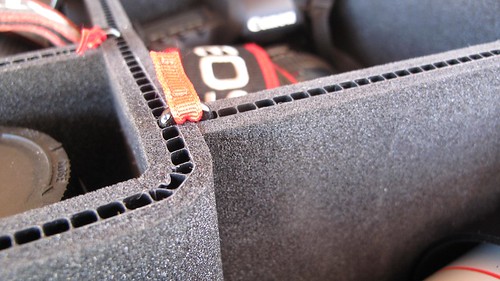
While I suspect the vast majority of TrekPak kits will be used for photography or video gear, the system would be equally versatile for many types of delicate equipment used by those working in the field: spotting scopes, satellite communication devices, radio-tracking receivers—you name it. I’m planning to devote an entire Pelican case to all the impedimenta one accumulates when using the Canon 5D MkII and III as a video camera: external microphone, follow-focus unit, suction mount for exterior vehicle shots, stabilizer for hand-held tracking, LCD viewfinder—a ridiculous amount of stuff.
Let’s see—1550 camera case, 1550 video equipment case, 1510 carry-on, all with TrekPak divider systems.
I guess I’m a convert.
TrekPak kits start at $65: TrekPak
BGAN review turns into a real-life test
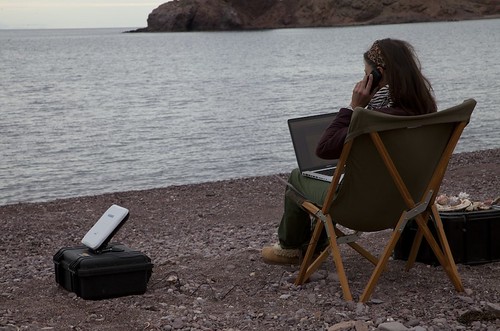
When we took the OCENS BGAN satellite communications kit to a remote beach in Mexico where we planned to celebrate the New Year with friends, we expected to have fun testing it by checking email and news, and maybe making a few phone calls to friends to evaluate the ease of use and reception.
As it turned out, the unit had to prove its value in much more tragic circumstances.
If you’re not yet familiar with the concept, BGAN (Broadband Global Area Network; just say “beegan”) allows both data and telephone communication from virtually anywhere on earth, via a compact portable antenna that links with one of four geosynchronous equatorial-orbit satellites. Roseann and I wanted a system that would allow us to send and receive email, post images and articles on the Web, and make critical telephone calls anywhere we parked the camper. BGAN technology now makes doing so easy and efficient (if not yet exactly cheap) using one’s laptop computer, which communicates with and through the antenna via either a cable or wi-fi connection to access and send data at up to 464 kbps. A separate telephone receiver can be used with the antenna on its own if you don’t need data service (although it will send and receive SMS messages).
We’ve been working with OCENS (“oceans,” for Ocean and Coastal Environmental Sensing) for over a year now—they sponsored the communications area at the 2012 Overland Expo. The company is a comprehensive resource for satellite communication systems, and can equip travelers, explorers, and scientists with BGAN kits, satellite telephones, and other types of equipment and software, either on a purchase or rental basis. Matt at OCENS sent us the latest Hughes 9202 terminal—the smallest Class 2 terminal on the market at barely over eight inches square—along with a Thrane and Thrane Explorer handset. The kit, with a rechargeable lithium-ion battery pack, comes tidily packaged in a Pelican 1450 case. A complete set of instructions for connecting to the Inmarsat satellite system comprises a single laminated card.
Our first morning on the beach in Mexico we made coffee and wandered about catching up with people we hadn’t seen in a long time. There was the usual round of campsite tours as we checked out who’d done what to their Four Wheel Campers or Volkswagen Westfalias or OzTents or FlipPacs. I took some video with the Canon 5D MkII, then moved down to the water’s edge to get some background footage of tidepools and birds. The water was glassy silver; barely a swell tumbled home on the gravel. Brown pelicans skimmed past just millimeters from the surface, defying physics. I heard the sound of an outboard motor, and saw two fishermen heading into the cove, so I set up the camera and got a shot of them traversing the frame. As the camera rolled I looked askance at the boat—a 12-foot, outboard-powered aluminum craft, painted camouflage, that would have been fine on a bass lake but seemed marginal for the Sea of Cortez even in calm weather. The men were obviously weekend sport fishermen; they carried what appeared to be light spinning gear. The two made a few casts in the cove, then motored off to the north.
The afternoon turned windy, as it usually does in winter in the Sea of Cortez, and by dusk a sizable surf was pounding the gravel beach in front of our truck, and whitecaps showed out in the open water. But early the next morning it was calm again when we heard another outboard, and saw three men dressed in foul-weather gear motor up to our beach in a panga—the sturdy and seaworthy fiberglass boat used for decades by Mexican fishermen. Behind the panga they towed a camouflage-painted aluminum boat, which, it developed as we talked with them, they’d found capsized, barely afloat—and empty except for an outboard motor and two fishing rods.
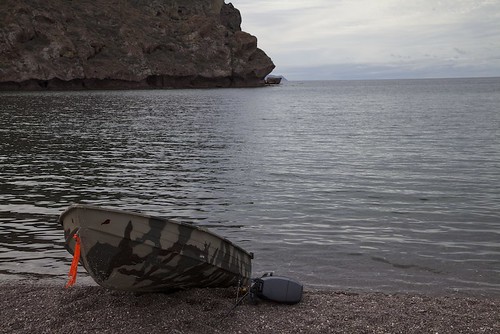
The men pulled the sad little boat up the beach and laid the rods and motor next to it. Meanwhile, I got out the BGAN kit, folded open the square white antenna, and pointed it skyward in the slight southeasterly direction of the Inmarsat equatorial satellite at 98ºW, used by the system in the Americas. Using the signal-strength indicator on the antenna’s LCD screen, it took just a few seconds of nudging to attain a reading over 50, the recommended minimum. As I was adjusting the antenna, Roseann opened her MacBook Pro, which instantly displayed the antenna’s status via a wi-fi connection. In a few more seconds, she was connected to the Web and looking up the phone number for the San Carlos Marina, 40 miles to the south. I plugged in the phone receiver and dialed the number—and within 15 minutes of when the panga landed we had relayed the information to the marina, who contacted the Mexican Coast Guard. Less than an hour later a fixed-wing spotter aircraft and two rigid-hulled inflatable boats (RIBs) were running a grid over the area.
I’d love to report the search found the two men alive and well. Sadly, the RIBs instead recovered the body of Edgar Osantes Loya from the sea, and in the meantime we learned that the two men we first saw in the aluminum boat had in fact picked up a third at their camp north of us. So the situation now involved one dead fisherman and two missing fishermen. The single dim ray of comfort was that the immediate search had at least recovered one body, to offer some closure to the man’s family.
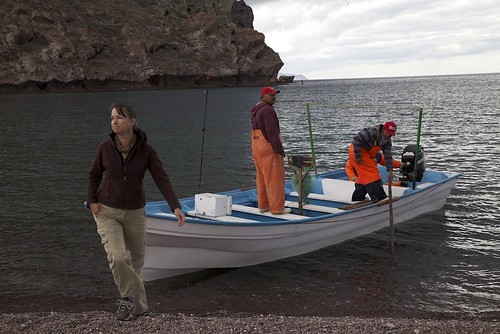
Word got out quickly. By that evening, friends and relatives of the missing men (who were residents of Hermosillo) had stopped by our camp and were driving up and down the coast. The next morning another panga stopped by, and the men reported they’d found a flotation device on a beach several kilometers south of us, along with two sets of footprints. By this time a helicopter had joined the search but was still circling over the sea—standard procedure since if the men were alive they’d be in much worse danger if still in the water. Once more Roseann and I fired up the OCENS unit. This time we had difficulty contacting the marina, and instead called friends in Tucson to have them try directly (which they were able to do).
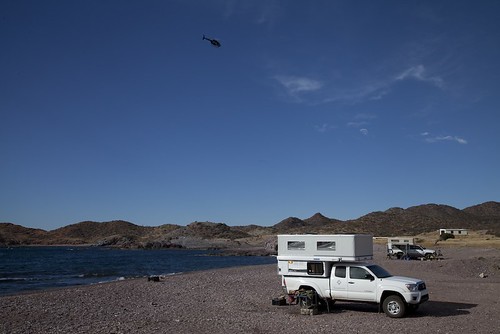
Several people in our group, along with a friend of the missing men, drove south on an inland track and found the footprints. Chuck Hathcock, a biologist and experienced tracker, followed them for a couple of miles until they disappeared completely in a rocky canyon. Meanwhile I hiked north along the cliff-interrupted coast with binoculars, but saw nothing that day or the next. Nor did other areas of the inland search prove fruitful.
Reviewing what we know of the timeline, it seems likely the boat capsized sometime in the afternoon or evening of the day before it was found. That meant a minimum 12 to 15-hour delay before the search was initiated. According to NOAA data, the water temperature in that region of the Sea of Cortez was around 64 degrees Fahrenheit. Confusion and loss of motor control from hypothermia at that temperature can occur in as little as an hour, with death following in as little as another hour. Thus, unless the other two men made it to shore very quickly, they would have shared the fate of their unfortunate companion.
The day after we returned home, we learned from El Imparcial that the official search had been called off, although relatives were still looking, and there remained hope that the two missing men, Daniel Romero Loya and Noé Loya, were still walking toward San Carlos. We’re continuing to seek news. In the meantime, thanks to the OCENS BGAN unit, at least one family will be able to lay a loved one to rest.
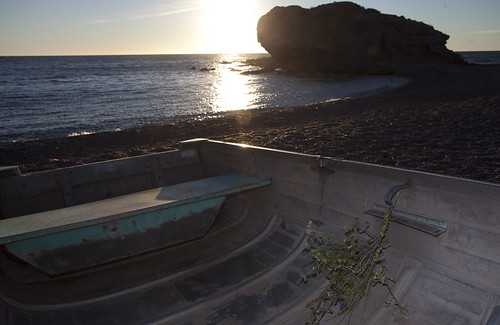
Find out more about satellite communications equipment at OCENS. The complete Hughes 9202 BGAN kit we used costs $2,895; the Thrane handset adds $199. A wide selection of air time plans is available, as well as rental options.
Transform your Hi-Lift jack

It isn’t very often I test a product that defies criticism even when subjected to the harshest analysis. But I’ve just been using a brand new accessory for the Hi-Lift jack, and I find myself at a loss to write anything that would approach even the level of nitpicking.
Anyone who has used a Hi-Lift jack knows it will do things no other jack will do. Anyone who has used one also knows the thing is a widow-maker if not handled with the same circumspection one would employ with a pissed-off rattlesnake. The operating handle continuously lies in wait for the head of a careless user to stray within its arc of movement. (Lose your grip then and a broken nose would be light punishment.) The lift mechanism is prone to jamming until doused with WD-40, and the selector lever frequently requires a stomp with a boot rather than a push with a finger to switch from “raise” to “lower.”
Then there’s stability. Now and then you want an unstable Hi-Lift, when using it as a “casting jack” to raise one end of a vehicle and then tip it sideways out of a rut. Far more often, the thing tips on its own when you don’t want it to. Woe to anyone trying to insert sand mats under the tires at that point—much less anyone attempting to change a tire. And human body parts are not all that are at risk: The Hi-Lift’s main beam will crease truck-body sheet metal effortlessly if the vehicle tips away from the baseplate.
Until now we just put up with these hazards to exploit the inarguable versatility of Bloomfield Manufacturing’s century-old invention. Now Richard Bogert of Bogert Manufacturing has solved one of the Hi-Lift’s salient drawbacks with a product of palm-to-forehead simplicity.
The Safe Jack comprises a sturdy, powdercoated steel baseplate into which the base of the Hi-Lift slots snugly. The plate offers exactly the increase in area (144 square inches total) as the ubiquitous orange plastic ORB jack base, to enhance flotation in soft sand or mud.
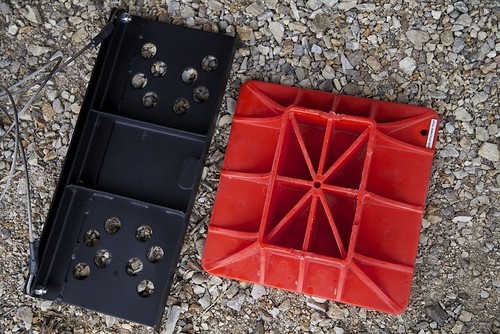 The Safe Jack base (left) offers the same flotation as the plastic base
The Safe Jack base (left) offers the same flotation as the plastic base
But the brilliance of the Safe Jack lies in the two swaged steel cables bolted to each corner of the base, which triangulate the jack’s structure by connecting to the top of the main beam with a quick-connect clevis pin. The user tensions the cables by simply screwing in an eyebolt snug against the main beam, and . . . shazam: Suddenly that tippy Hi-Lift is the Rock of Gibraltar. I raised the front of my FJ40 with the Hi-Lift a foot off-center—normally a recipe for a drunken sideways flop as soon as the weight comes off the tires—hung both wheels in the air, then shoved sideways on the vehicle. Nothing—it rocked an inch or two and settled back comfortably. The total extra time to set up the Safe Jack system was maybe 30 seconds.
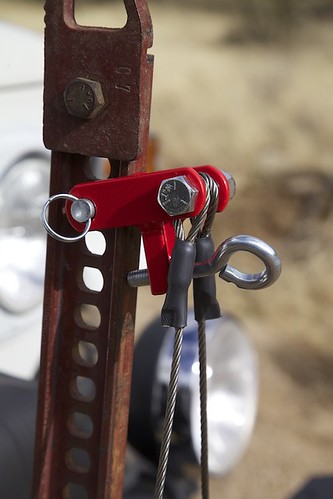 The Safe Jack's cables attach with a pin and tension with a simple eyebolt.
The Safe Jack's cables attach with a pin and tension with a simple eyebolt.
In the end, I found one small thing I thought would improve the Safe Jack, although it’s far from a criticism: I plan to replace the bolts securing the bottom ends of the cables with clevis pins and J-clips. That way if I want just the base I can quickly remove the cables to keep them out of the way.
The Safe Jack provides all the flotation benefits of an expanded baseplate, then adds a different universe of stability and safety. I’m finding myself viewing my 20-year-old Hi-Lift as an entirely new tool. If you’re a Hi-Lift jack owner—or have avoided buying one because of all the horror stories you’ve heard—trust me, this accessory will change the way you view your jack too. For 69 bucks it’s a steal.
The Safe Jack is available direct from Bogert Manufacturing: Go here. They also make some intriguing accessories for bottle jacks which I hope to test soon.
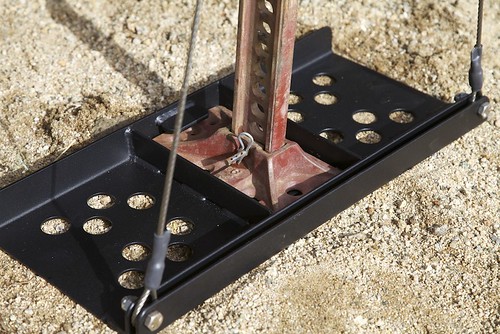
An update, if you missed it elsewhere. Bogert has improved an already excellent product by modifying the top piece. See the review here. It's available as a very affordable upgrade if you bought the original version.
Hint: When using “Search,” if nothing comes up, reload the page, this usually works. Also, our “Comment” button is on strike thanks to Squarespace, which is proving to be difficult to use! Please email me with comments!
Overland Tech & Travel brings you in-depth overland equipment tests, reviews, news, travel tips, & stories from the best overlanding experts on the planet. Follow or subscribe (below) to keep up to date.
Have a question for Jonathan? Send him an email [click here].
SUBSCRIBE
CLICK HERE to subscribe to Jonathan’s email list; we send once or twice a month, usually Sunday morning for your weekend reading pleasure.
Overland Tech and Travel is curated by Jonathan Hanson, co-founder and former co-owner of the Overland Expo. Jonathan segued from a misspent youth almost directly into a misspent adulthood, cleverly sidestepping any chance of a normal career track or a secure retirement by becoming a freelance writer, working for Outside, National Geographic Adventure, and nearly two dozen other publications. He co-founded Overland Journal in 2007 and was its executive editor until 2011, when he left and sold his shares in the company. His travels encompass explorations on land and sea on six continents, by foot, bicycle, sea kayak, motorcycle, and four-wheel-drive vehicle. He has published a dozen books, several with his wife, Roseann Hanson, gaining several obscure non-cash awards along the way, and is the co-author of the fourth edition of Tom Sheppard's overlanding bible, the Vehicle-dependent Expedition Guide.




